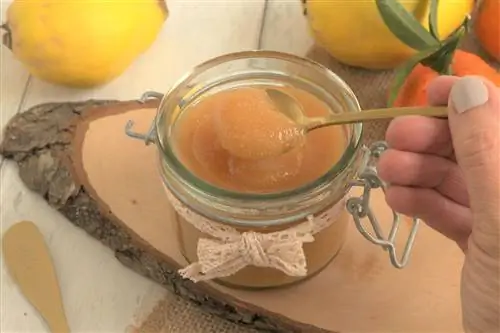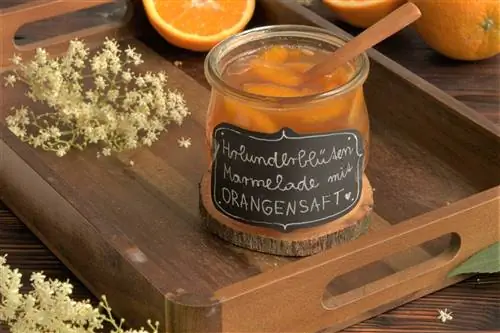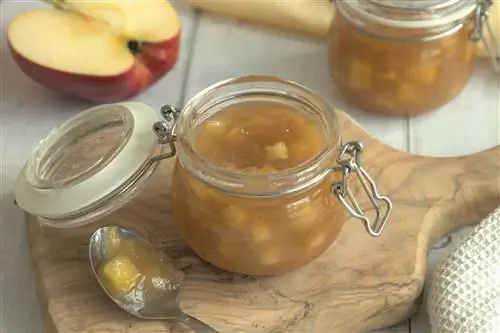- Author admin [email protected].
- Public 2023-12-17 03:39.
- Last modified 2025-01-24 12:45.
The classic is of course quince jelly, but quinces are also used a lot for jam or preserves, as it is more correctly called today. The jam is much easier and quicker to make. Besides, not everyone likes the gelatinous consistency of jellies.
Harvest of fruits
Quinces are harvested when they are not yet fully ripe. The later they are picked, the more the pectin naturally occurring in the fruit breaks down. The best time to harvest is when the color of the fruit changes from green to yellow. Grass-green fruits don't have as good a taste, even if you let them ripen. If you harvest too late, the fruits will quickly turn brown. If you want to store them, you have to pick them shortly before they are ripe, then they will last for around 8 weeks. However, freshly harvested quinces should be used to make jam.
Preparing the fruits
The down or fur of the quinces must be rubbed thoroughly using a coarse cloth. It contains bitter substances. The fruit can then be peeled. However, the fruits can also be used unpeeled. If you plan to do this, you can also brush the shell vigorously until the fuzz is gone. The brush must be quite hard, which can cause small scratches on the shell. This means that the fruit must be processed quickly, if possible immediately.
Making jam
The quinces must first be chopped. The stems are removed. The core casings can also be recycled. Put all the quince pieces in a pot. The fruits must be slightly covered with water. They are then cooked until soft. It doesn't take long, about 30 minutes. Just let the pieces of fruit simmer gently. If they are soft, the water is poured off. This could still be used to make quince jelly. The soft pieces of fruit are passed through a sieve. The finer the sieve, the finer the fruit puree will be.
Now the preserving sugar is added to the fruit pulp. Depending on the preserving sugar used (1:1, 2:1 or 3:1), the amount of sugar must be measured. The sugar is mixed into the fruit mixture. Everything is brought to the boil briefly. Be careful, the mixture will splash. It then has to simmer for about 10 minutes. The jam is then poured into the prepared jars, which must be closed immediately.
If you want to spice up the jam, you can add the pulp of two vanilla beans and about 20 ml of almond liqueur per kilogram of fruit.
General
The preserving sugar in a ratio of 1:1 is the classic. If you like it less sweet, it's better to use the 3:1. There is also preserving sugar suitable for diabetics. The gelling test is important so that you know whether the jam will set. Add 1 to 2 teaspoons of jam on a cold plate. If the mixture does not set quickly, you must continue stirring.






